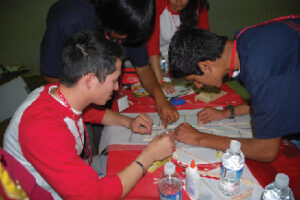Cognitive Development
More complex thinking abilities emerge during adolescence. Some researchers suggest this is due to increases in processing speed and efficiency rather than as the result of an increase in mental capacity—in other words, due to improvements in existing skills rather than the development of new ones (Bjorkland, 1987; Case, 1985). During adolescence, teenagers move beyond concrete thinking and become capable of abstract thought. Recall that Piaget refers to this stage as formal operational thought. Teen thinking is also characterized by the ability to consider multiple points of view, imagine hypothetical situations, debate ideas and opinions (e.g., politics, religion, and justice), and form new ideas (Figure 3). In addition, it’s not uncommon for adolescents to question authority or challenge established societal norms.
Cognitive empathy, also known as theory-of-mind (which we discussed earlier with regard to egocentrism), relates to the ability to take the perspective of others and feel concern for others (Shamay-Tsoory, Tomer, & Aharon-Peretz, 2005). Cognitive empathy begins to increase in adolescence and is an important component of social problem-solving and conflict avoidance. According to one longitudinal study, levels of cognitive empathy begin rising in girls around 13 years old, and around 15 years old in boys (Van der Graaff et al., 2013). Teens who reported having supportive fathers with whom they could discuss their worries were found to be better able to take the perspective of others (Miklikowska, Duriez, & Soenens, 2011).

Psychosocial Development
Adolescents continue to refine their sense of self as they relate to others. Erikson referred to the task of the adolescent as one of identity versus role confusion. Thus, in Erikson’s view, an adolescent’s main questions are “Who am I?” and “Who do I want to be?” Some adolescents adopt the values and roles that their parents expect from them. Other teens develop identities that are in opposition to their parents but align with a peer group. This is common as peer relationships become a central focus in adolescents’ lives.
As adolescents work to form their identities, they pull away from their parents, and the peer group becomes very important (Shanahan, McHale, Osgood, & Crouter, 2007). Despite spending less time with their parents, most teens report positive feelings toward them (Moore, Guzman, Hair, Lippman, & Garrett, 2004). Warm and healthy parent-child relationships have been associated with positive child outcomes, such as better grades and fewer school behavior problems, in the United States as well as in other countries (Hair et al., 2005).
It appears that most teens don’t experience adolescent storms and stress to the degree once famously suggested by G. Stanley Hall. Only small numbers of teens have major conflicts with their parents (Steinberg & Morris, 2001), and most disagreements are minor. For example, in a study of over 1,800 parents of adolescents from various cultural and ethnic groups, Barber (1994) found that conflicts occurred over day-to-day issues such as homework, money, curfews, clothing, chores, and friends. These types of arguments tend to decrease as teens develop (Galambos & Almeida, 1992).
Identity Formation

Adolescence is one of the time periods of particular interest to psychologists, especially due to the focus on identity formation, which often involves a period of exploration followed by commitments to particular identities. Adolescence is characterized by risky behavior, which is made more likely by changes in the brain in which reward-processing centers develop more rapidly than cognitive control systems, making adolescents more sensitive to rewards than to possible negative consequences.
Marcia (1966) described identity formation during adolescence as involving both decision points and commitments with respect to ideologies (e.g., religion, politics) and occupations. He described four identity statuses: foreclosure, identity diffusion, moratorium, and identity achievement.
The four identity statuses
- Foreclosure occurs when an individual commits to an identity without exploring options.
- Identity diffusion occurs when adolescents neither explore nor commit to any identities.
- Moratorium is a state in which adolescents are actively exploring options but have not yet made commitments.
- Identity achievement occurs when individuals have explored different options and then made identity commitments.
The sub-area of research that explores racial, ethnic, gender, and sexual identity development examines the complex processes by which individuals come to understand and construct their sense of self in relation to these dimensions of identity. This field delves into how individuals navigate and make meaning of their racial and ethnic identities, the roles and expectations associated with gender, and the development of sexual orientation. Scholars in this area investigate the influences of culture, socialization, experiences of discrimination, and personal reflection in shaping individuals’ understanding, expression, and integration of these identities throughout their lifespan. By examining these multifaceted aspects of identity development, researchers aim to enhance our understanding of the unique experiences, challenges, and strengths that individuals experience as they learn more about their identities in a complex and evolving social landscape.